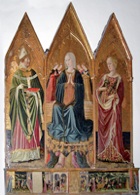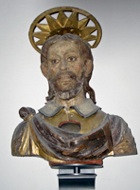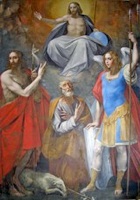


Fresco (ca. 1380) of Palazzo Vescovile
The facade of what was then SS John and Euphemia
was decorated with frescoes of these saints
Old Chancellery, Palazzo Vescovile
The art collection of the diocese is exhibited in five rooms on the first floor of the north wing of Palazzo Vescovile that formed the Appartamento del Cardinale (i.e. of Bishop Cardinal Cesare Facchinetti (1655 to 1672). The vaults of most of these rooms were frescoed in the Rococo style after the 1762 earthquake.
A passage from the museum leads to Sant' Eufemia.
Room 1
San Martino Dossal (13th century)

This dossal came from San Martino, Trevi. It depicts the Madonna and Child with four scenes to the sides:
-
✴two scenes from the life of Christ (the Flagellation and the Crucifixion) above; and
-
✴two scenes from the life of St Martin, only one of which (St Martin gives part of his cloak to a poor man, on the left) is still legible.
Paliotto di Santa Maria di Ponte (early 14th century)

This damaged rectangular dossal, which is attributed to the Primo Maestro di Santa Chiara di Montefalco, came from Santa Maria di Ponte, Borgo Cerreto outside Spoleto. It depicts:
-
✴Christ in Majesty within a mandorla surrounded by five roundels containing the symbols of the Evangelist and an Agnus Dei;
-
✴a censing angel and three standing saints on each side of the upper register; and
-
✴the remains of two narrative scenes (an Annunciation and Nativity) and four busts of saints in the lower register.
Madonna and Child (14th century)

The panel depicts the Madonna and Child enthroned in front of a cloth of honour held by angels. The baby Jesus holds a bird.
Room 3
Madonna and Child with prophets (ca. 1315)

The panel, which probably formed the central panel of a triptych, depicts the baby Jesus kissing His mother’s cheek. He wears a Franciscan habit tied with a cord. The prophets in the spandrels carry scrolls containing Marian prophecies.
Madonna and Child with angels (15th century)

The panel depicts the Madonna and Child with angels. Christ above holds a book with the words (translated) “I am the light of the world”.
Sant’ Eufemia Tryptych (1450)

The altarpiece depicts:
-
✴the Virgin of the Assumption, with four angels and the Apostles in the central panel;
-
✴St John of Spoleto (whose relics were under the altar) on the left; and
-
✴St Lucy on the right.
The predella depicts three scenes the martyrdom of St Lucy.
Room 4
Madonna della Neve (ca. 1464)

The altarpiece depicts the Virgin with St Sebastian and Pope Liberius. Two angels at the bottom kneel before a Crucifix in a tabernacle.
The iconography of the Madonna of the snow relates to the vision of Pope Liberius in which the Madonna caused snow to fall in August on the site in Rome on which she wanted him to build Santa Maria Maggiore. Pope Liberius is depicted pointing a plan of the church in the snow.
Madonna and Child with saints (ca. 1485)

The main panel depicts the Madonna suckling the baby Jesus, flanked by SS Montanus and Bartholomew, the patron saints of Todiano. The scenes in the predella relate to SS Montanus and Bartholomew respectively:
-
✴On the left, a bear and an ox are harnessed to a plough. The bear had killed the other ox, after which the farmer had prayed to St Montanus, who ordered the bear to take its place.
-
✴On the right, St Bartholomew the flayed apostle is represented with his skin over his shoulders.
Nativity (16th century)

The altarpiece depicts the Virgin and St Joseph kneeling before the baby Jesus, who lies on straw in the stable. There are two associated scenes in the background:
-
✴the announcement of the nativity to the shepherds; and
-
✴the arrival of the Magi.
Scholars have linked this work stylistically to two others by Domenico Beccafumi:
-
✴the Nativity (ca. 1545) in the Kress Collection, Allentown Art Museum, Allentown, Pennsylvania; and to
-
✴the Annunciation (1545-6) in SS Martino e Vittorio, Sarteano (near Siena), illustrated in this page on the artist in Wikipedia.
Room 5
SS Peter and Paul (1663)

The figures displayed (SS Peter and Paul) were originally on the inside of the doors, and thus stood to the sides of the Crucifix when the tabernacle was open for liturgical purposes. It was more normally closed, when the figures of SS Emilian and John the Baptist on the outer doors were displayed.
The panel of St Peter is signed by Giovanni Giacomo Tobiolo (from Urbino), and dated.
Room 6
Madonna of the Rosary (17th century)

The panel depicts the Madonna and Child in glory, passing rosaries to SS Dominic and Catherine of Siena and [with a pope, a bishop and a number of Rosarians behind them].
Room 7
Reliquary Bust of St Pantaleon (16th century)

Archbishop Bruno, the brother of the Emperor Otto I:
-
✴took some of the relics of St Gregory of Spoleto from San Gregorio Maggiore to Cologne in 951; and
-
✴acquired the body of St Pantaleon from Nicomedia and translated it to Cologne in 964.
This suggests that the relic of St Pantaleon was sent from Cologne to Spoleto as a quid pro quo.
Bust of Pope Urban VIII (1640-4)

St Philip Neri (ca. 1640)

Inscription

Bishop Paolo Sanvitale (who probably had a particular veneration for "San Vitale") translated the relics and the inscription to the Duomo in 1597. The inscription was broken, probably during its translation but it is known from a transcription contained in a letter written by Bishop Sanvitale and from this surviving fragment. (A reliquary containing the tibia of of St Vitalis, which Bishop Sanvitale commissionedat the time of the translation, is now in the Cappella delle Reliquie in the Duomo).
Birth of the Virgin (ca. 1735)

This altarpiece by Sebastiano Conca came from Santa Maria della Manna d’ Oro.
Holy Family (ca. 1735)
Christ the Redeemer with saints (ca. 1600)

Room 9
St Joseph and the Baby Jesus (ca. 1740)

St Mary Magdalene (date ??)

Sala Barberini (Room 2)

This room is to the left as you enter.
Circumcision of Jesus (17th century)

Virgin and Servite Order (1720)

Descent of the Holy Spirit (ca. 1680)

Adoration of the Magi (17th century)

Works not Exhibited
Marble bust of a man (5th century)
This bust was removed in 1978 from the the ruined church of San Giovanni di Panaria, between Castello di Perchia and Baiano.


